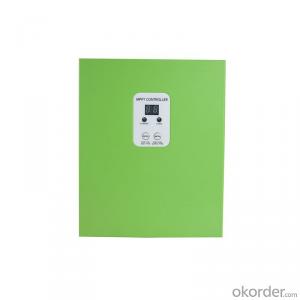MPPT Solar Charge Controller 30A,12/24V/48V Automatic Recognition,15A~40A
- Loading Port:
- China main port
- Payment Terms:
- TT OR LC
- Min Order Qty:
- 20 unit
- Supply Capability:
- 9999 unit/month
OKorder Service Pledge
OKorder Financial Service
You Might Also Like
Home system MPPT solar panel charge controller with remote control 15A 25A 30A 40A
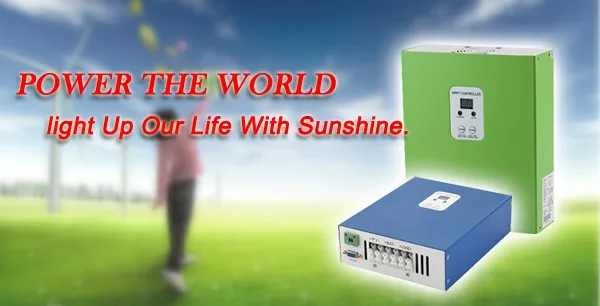
| Introduction |
This e-SMART MPPT (maximum Power Point Tracking) solar charge controller is a smart solar controller with automatic recognition function, smart charging and discharging function, three stages charging function to protect battery. It can increase 30%~60% efficiency than traditional PWM controller. It supports many kinds of batteries.It also have RS232 communication function.
| Product Show |
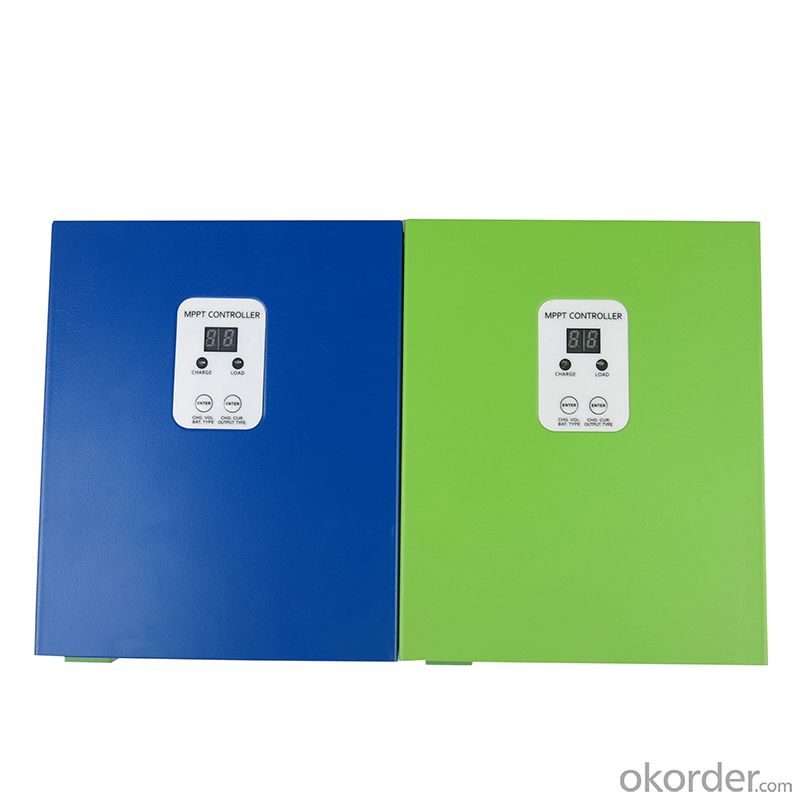
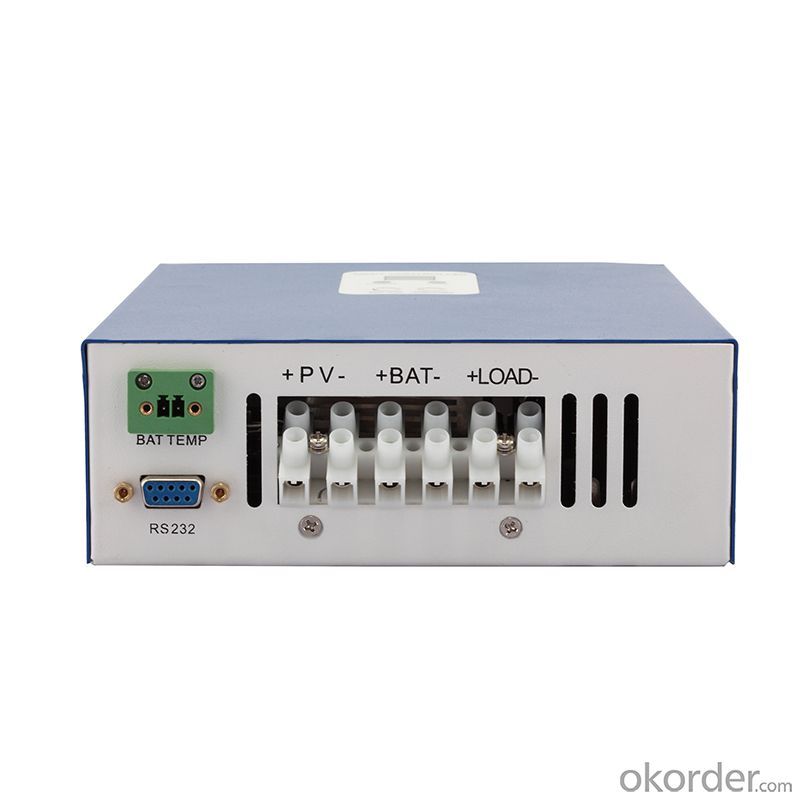
| Features |
1. MPPT charging mode, peak efficiency up to 99%, saving 30%~60% solar panel than traditional PWM controller.
2. DC12V/24V/48V battery system automatic recognition, users can use it in different system conveniently.
3. Maximum PV input voltage up to DC100V.
4. Three stages charge: fast charge(MPPT), constant voltage charge,floating charge, It can protect batteries well .
5. Three option of discharge: on mode and off mode and PV voltage(solar) control mode.
6. Users can choose 4 kinds of commonly standard batteries(Sealed lead acid, Vented, Gel, NiCd). Other kinds of batteries can be defined by users.
7. Digital tube can display battery voltage and charging current. The software can display various parameters such as model number, PV input voltage, battery type, battery voltage, charging current, charging power, working condition.
8. RS232 communication, we can offer communication protocol also, it’s convenient for user’s integration management.
9. This controller can be paralleled infinitely.
10. CE and RoHS Certifications are approved.We can help clients to approve other certifications.
11. 2 years warranty; 3~10 years extended technical service.
| Application |
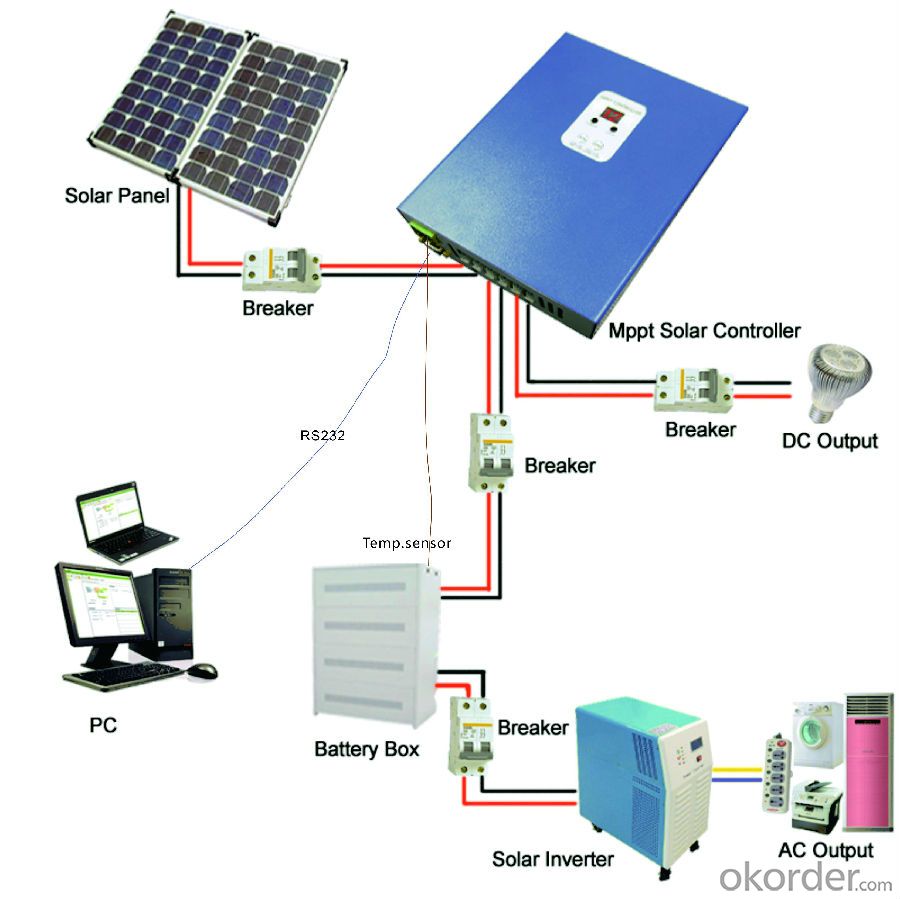
| Parameter |
MPPT solar controller modes:I-P-e-SMART-12V/24V/48V-series | 15A | 20A | 25A | 30A | 40A | |
Charge mode | MPPT(maximum power point tracking) | |||||
Charge method | Three stages: constant current(MPPT),constant voltage,floating charge | |||||
System type | DC12V/24V/48V | Automatic recognition | ||||
System voltage | 12V system | DC9V~DC15V | ||||
24V system | DC18V~DC30V | |||||
48V system | DC36V~DC60V | |||||
Soft start time | 12V/24V/48V system | ≤3S | ||||
Dynamic response recovery time | 12V/24V/48V system | 500us | ||||
MPPT efficiency | 12V/24V/48V system | ≥96.5%,≤99% | ||||
INPUT CHARACTERISTICS | ||||||
MPPT working voltage range | 12V system | DC14V~DC100V | ||||
24V system | DC30~DC100V | |||||
48V system | DC60~DC100V | |||||
Low input voltage protection point | 12V system | DC14V | ||||
24V system | DC30V | |||||
48V system | DC60V | |||||
Low input voltage Recovery point | 12V system | DC18V | ||||
24V system | DC34V | |||||
48V system | DC65V | |||||
High input voltage protection point | 12V/24V/48V system | DC110 | ||||
High input voltage recovery point | 12V/24V/48V system | DC100V | ||||
Maximum PV power | 12V system (W) | 213 | 284 | 355 | 426 | 568 |
24V system (W) | 426 | 568 | 710 | 852 | 1136 | |
48V system (W) | 852 | 1136 | 1420 | 1704 | 2272 | |
CHARGE CHRECTRESTICS | ||||||
Selectable Battery Types (Default Gel battery) | 12V/24V/48V system | Sealed lead acid, Vented, Gel, NiCd battery (Other types of the batteries also can be defined)) | ||||
Constant Voltage | 12V/24V/48V system | Please check the charge voltage according to the battery type form. | ||||
Floating Charge Voltage | 12V/24V/48V system | |||||
Rated Input Current | 12V/24V/48V system | 15A | 20A | 25A | 30A | 40A |
Current-limit Protection | 12V/24V/48V system | 20A | 25A | 30A | 35A | 45A |
Temperature Factor | 12V/24V/48V system | ±0.02%/℃ | ||||
Temperature Compensation | 12V/24V/48V system | 14.2V-(The highest temperature-25℃)*0.3 | ||||
Output Ripples(peak) | 12V/24V/48V system | 200mV | ||||
Output Voltage Stability Precision | 12V/24V/48V system | ≤±1.5% | ||||
The specification is only for reference. Subject to change without prior notice.
RS232 Function working stat |
The Figures of the PC Firmware and Testing Software:
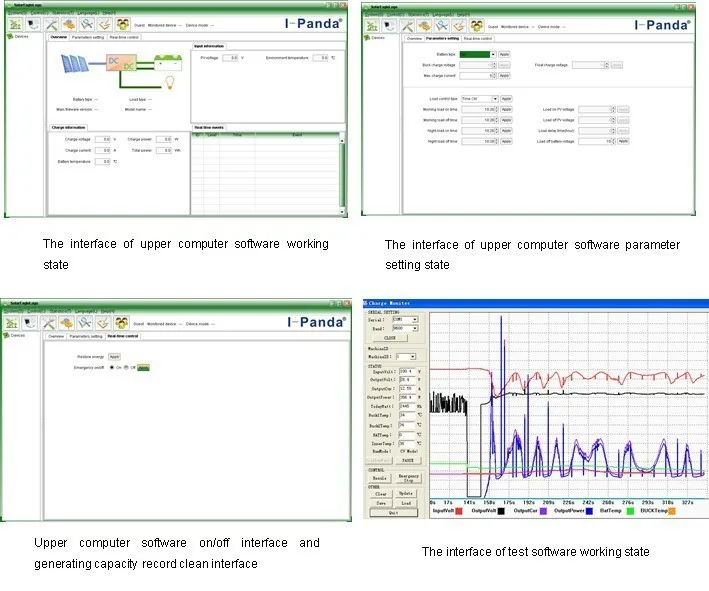
We provide OEM and ODM service.The 36V/72V/96V model also can be custom made for you.
Packaging |
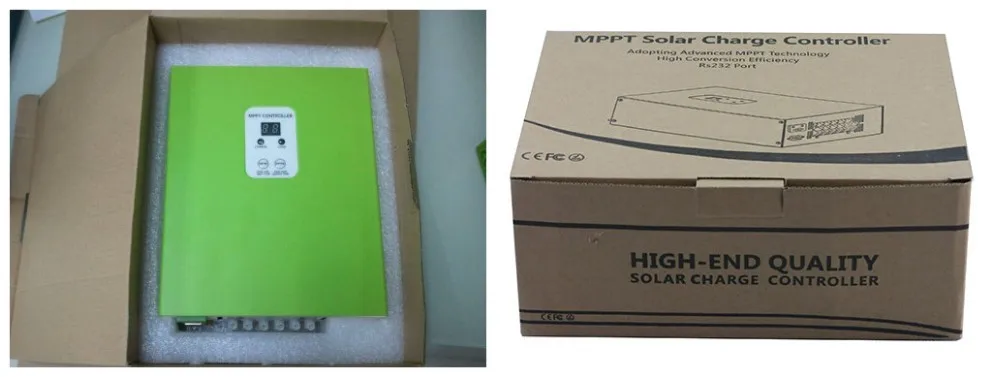
Certifications |
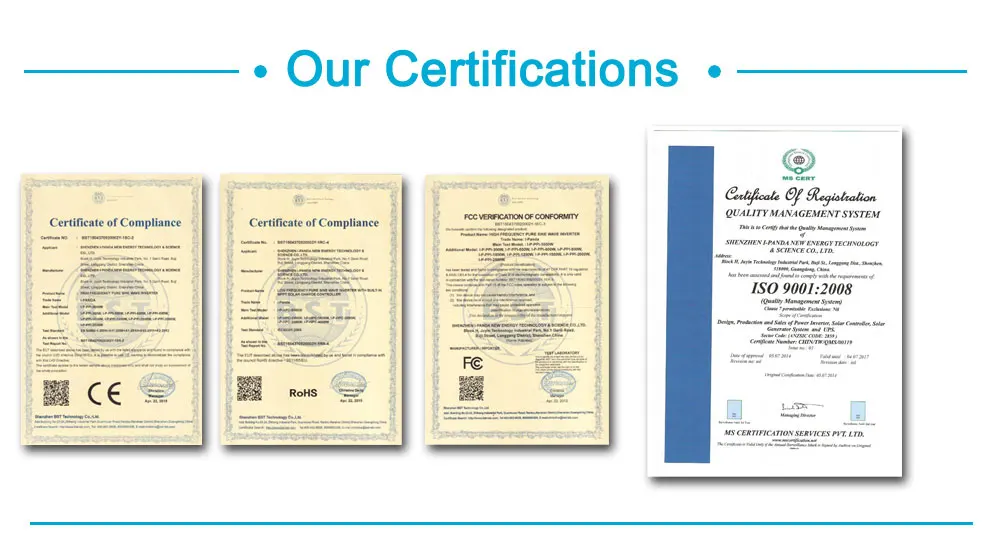
F&Q: |
Q1. How to ensure and monitor the products quality?
A1: We have established a perfect Quality Management System, In strict
accordance with ISO9001: 2008 quality system and ISO14001 environment system for quality assurance management;
Our ISO9001:2008 Quality System certificate encoding: CHIN/TW/QMS/00119;
Our ISO14001 Environment System certificate encoding: CHIN/TW/EMS/00028;
Q2. What is the warranty of products?
A2: The warranty period of different products are different; 5 years, 3 years, 2 years, 1 years; More details please refer to the product specification or manual; we will provide free life-long technical support ;
Q3. What is the difference between MPPT&PWM?
A3. MPPT charging mode, peak efficiency up to 99%, saving 30%~60% solar panel than traditional PWM controller.
- Q:What is the temperature compensation range of a solar controller?
- The temperature compensation range of a solar controller typically varies between -10°C to +40°C.
- Q:Can a solar controller be used with a generator backup system?
- Yes, a solar controller can be used with a generator backup system. The solar controller helps regulate the charging of batteries from solar panels, while the generator backup system provides alternative power during periods of low sunlight or high demand. The two systems can work together to ensure a reliable and efficient power supply.
- Q:Can a solar controller be used with sealed batteries?
- Yes, a solar controller can be used with sealed batteries. The solar controller regulates the charging process and prevents overcharging, which is beneficial for maintaining the longevity and performance of sealed batteries.
- Q:Can a solar controller be used with solar panel cooling systems?
- Solar panel cooling systems can indeed utilize a solar controller. The solar controller's role encompasses the regulation of power flow from the solar panels to either the batteries or grid. Additionally, it monitors and safeguards the batteries against overcharging or discharging. In the context of solar panel cooling systems, the solar controller can be employed to energize and manage the cooling mechanism. This guarantees that the solar panels maintain ideal temperatures, thereby enhancing their efficiency and lifespan. By employing a solar controller, the cooling system can operate with maximum effectiveness and efficiency, thus optimizing the solar panels' productivity.
- Q:What is the role of a solar controller in preventing damage to the solar panels from hail or storm events?
- The role of a solar controller in preventing damage to solar panels from hail or storm events is primarily to act as a protective mechanism. Hailstorms and severe storms can pose significant risks to solar panels, and a solar controller plays a crucial role in mitigating these risks. Firstly, a solar controller is responsible for monitoring the weather conditions. It can detect the approach of a hailstorm or severe storm by analyzing data from various sensors and weather forecasting systems. This early detection allows the solar controller to initiate precautionary measures before the storm hits. Once a storm is detected, the solar controller can activate protective mechanisms to safeguard the solar panels. One such mechanism is the ability to automatically tilt the panels to an angle that minimizes the surface area exposed to hail or storm winds. This adjustment reduces the chances of hailstones or debris directly hitting the panels, thereby preventing potential damage. Additionally, solar controllers often have built-in sensors that can detect the impact of hailstones on the panels. If the sensors detect a certain level of impact, the controller can automatically shut down the panels to prevent further damage. This feature is crucial as it prevents the panels from generating electricity during a storm, reducing the risk of electrical surges or short circuits. Furthermore, solar controllers can also activate protective coverings or shields to physically shield the panels from hail or storm-induced damage. These coverings are usually made of durable materials that can withstand the impact of hailstones or debris, providing an additional layer of protection to the panels. Overall, the role of a solar controller in preventing damage to solar panels from hail or storm events is to monitor weather conditions, initiate precautionary measures, adjust panel angles, shut down panels if necessary, and provide physical protection. By performing these functions, solar controllers play a crucial role in ensuring the longevity and efficiency of solar panel systems during adverse weather conditions.
- Q:Can a solar controller be used in a hybrid solar system?
- Yes, a solar controller can be used in a hybrid solar system. A solar controller, also known as a charge controller, is used to regulate the charging and discharging of batteries in a solar power system. In a hybrid solar system, which combines solar power with another source of energy such as a grid or generator, a solar controller is still necessary to manage the battery charging process. In a hybrid solar system, the solar controller helps optimize the use of solar energy by ensuring that the batteries are charged efficiently from the solar panels. It prevents overcharging, which can damage the batteries, and also prevents deep discharge, which can reduce their lifespan. Additionally, the solar controller can provide additional features such as battery temperature sensing and load control, further enhancing the performance and longevity of the battery bank. By using a solar controller in a hybrid solar system, you can effectively integrate and manage different sources of energy, allowing you to maximize the use of solar power while still having the flexibility to switch to alternative sources when needed. This ensures that your hybrid solar system operates efficiently, effectively utilizing the available resources and providing you with a reliable and sustainable power supply.
- Q:Can a solar controller be used with solar panels of different lifespans?
- Yes, a solar controller can be used with solar panels of different lifespans. The main function of a solar controller is to regulate the charging process and prevent overcharging of the batteries connected to the solar panels. It does not directly interact with the solar panels themselves. Therefore, as long as the solar panels are compatible with the solar controller in terms of voltage and current, they can be used together regardless of their lifespan. However, it is important to consider the efficiency and performance of the older solar panels as they may produce less power compared to newer ones, which could affect the overall system performance.
- Q:What is the maximum number of solar panels a solar controller can handle?
- The maximum number of solar panels a solar controller can handle depends on the specific model and its specifications. Different solar controllers have different capacities, typically ranging from a few panels to several dozen panels. It is important to consult the manufacturer's guidelines or product specifications to determine the maximum number of solar panels that a particular solar controller can handle.
- Q:Can a solar controller increase the efficiency of a solar panel?
- A solar panel's efficiency can be increased with the help of a solar controller. Also known as a charge controller, a solar controller is a vital component in solar power systems. Its main purpose is to regulate the flow of electricity between the solar panel and the battery bank. One of the primary functions of a solar controller is to safeguard the batteries from overcharging or over-discharging. By monitoring the voltage and current levels, it ensures that the batteries are charged optimally and not subjected to excessive voltage or discharged below safe levels. This prevents energy wastage and extends the lifespan of the batteries, indirectly enhancing the overall efficiency of the system. Furthermore, advanced solar controllers often incorporate Maximum Power Point Tracking (MPPT) technology. These controllers utilize algorithms to continuously track and adjust the electrical load on the solar panel, enabling the extraction of maximum power output irrespective of temperature or shading conditions. Consequently, the solar panel can operate at its highest efficiency, even in less-than-ideal circumstances, resulting in increased energy production. To summarize, a solar controller plays a critical role in optimizing the performance of a solar panel system by preventing battery damage and maximizing power output. By regulating and optimizing the charging process, it can significantly enhance the efficiency of a solar panel.
- Q:How does a solar controller handle power fluctuations in the grid-tied system?
- A solar controller is an essential component of a grid-tied system that helps manage power fluctuations from the grid. When there are power fluctuations in the grid, such as sudden voltage spikes or drops, the solar controller acts as a mediator to stabilize the flow of power between the solar panels and the grid. One of the primary functions of a solar controller is to monitor the voltage and frequency of the grid. It constantly measures the incoming power and compares it to the predefined range of acceptable values. If the voltage or frequency deviates from the set parameters, the solar controller takes appropriate action to mitigate the fluctuations. In the event of a power surge from the grid, the solar controller employs various protective mechanisms to safeguard the system. It can temporarily disconnect the grid connection or utilize surge protection devices to prevent the excess voltage from damaging the solar panels or other connected equipment. Similarly, if there is a sudden drop in the grid voltage, the solar controller can regulate the power flow to compensate for the lower input. It may adjust the inverter settings or temporarily disconnect the grid connection if the voltage falls below a certain threshold. This prevents potential damage to the solar panels and ensures a stable power supply to the connected loads. Furthermore, a solar controller also plays a crucial role in maintaining the stability of the grid-tied system during grid outages. In such situations, the solar controller is programmed to immediately isolate the system from the grid to prevent back-feeding, which could pose a risk to the utility workers trying to restore power. Once the grid is restored, the solar controller verifies the stability before re-establishing the connection. Overall, a solar controller is capable of effectively handling power fluctuations in a grid-tied system by constantly monitoring and regulating the flow of power. Its ability to detect deviations, provide protection against surges or drops, and maintain grid stability makes it an indispensable component for a reliable and efficient solar energy system.
1. Manufacturer Overview |
|
|---|---|
| Location | |
| Year Established | |
| Annual Output Value | |
| Main Markets | |
| Company Certifications | |
2. Manufacturer Certificates |
|
|---|---|
| a) Certification Name | |
| Range | |
| Reference | |
| Validity Period | |
3. Manufacturer Capability |
|
|---|---|
| a)Trade Capacity | |
| Nearest Port | |
| Export Percentage | |
| No.of Employees in Trade Department | |
| Language Spoken: | |
| b)Factory Information | |
| Factory Size: | |
| No. of Production Lines | |
| Contract Manufacturing | |
| Product Price Range | |
Send your message to us
MPPT Solar Charge Controller 30A,12/24V/48V Automatic Recognition,15A~40A
- Loading Port:
- China main port
- Payment Terms:
- TT OR LC
- Min Order Qty:
- 20 unit
- Supply Capability:
- 9999 unit/month
OKorder Service Pledge
OKorder Financial Service
Similar products
New products
Hot products
Hot Searches
Related keywords
